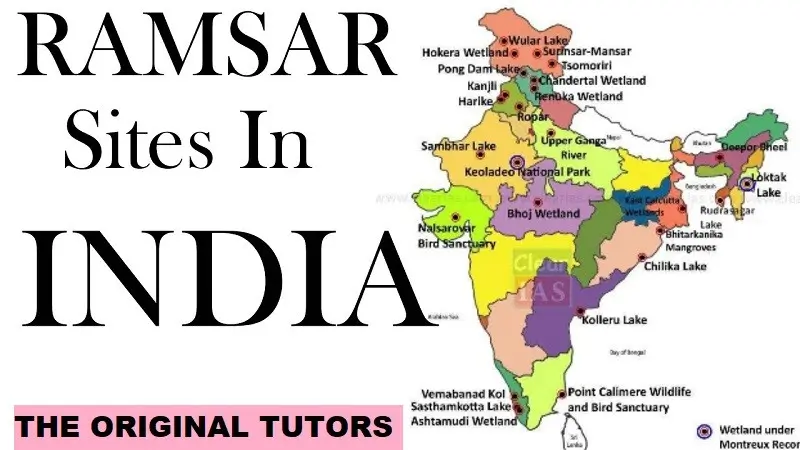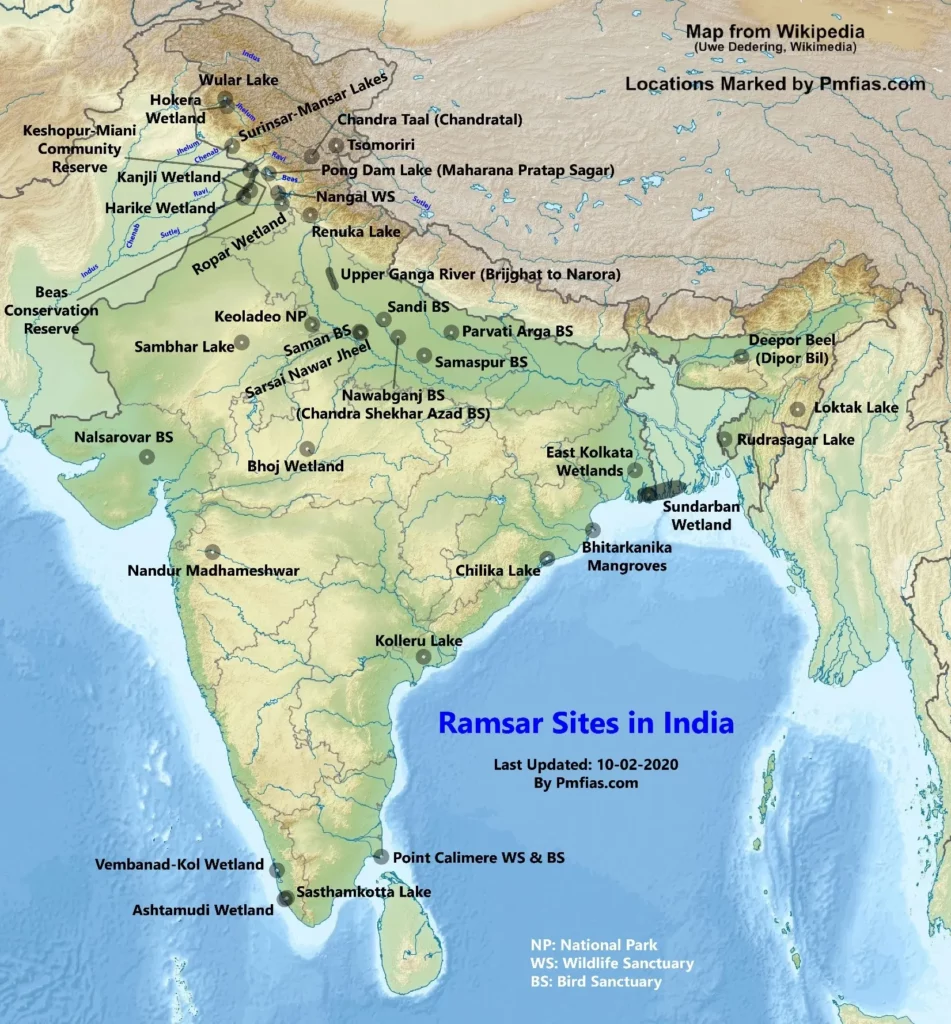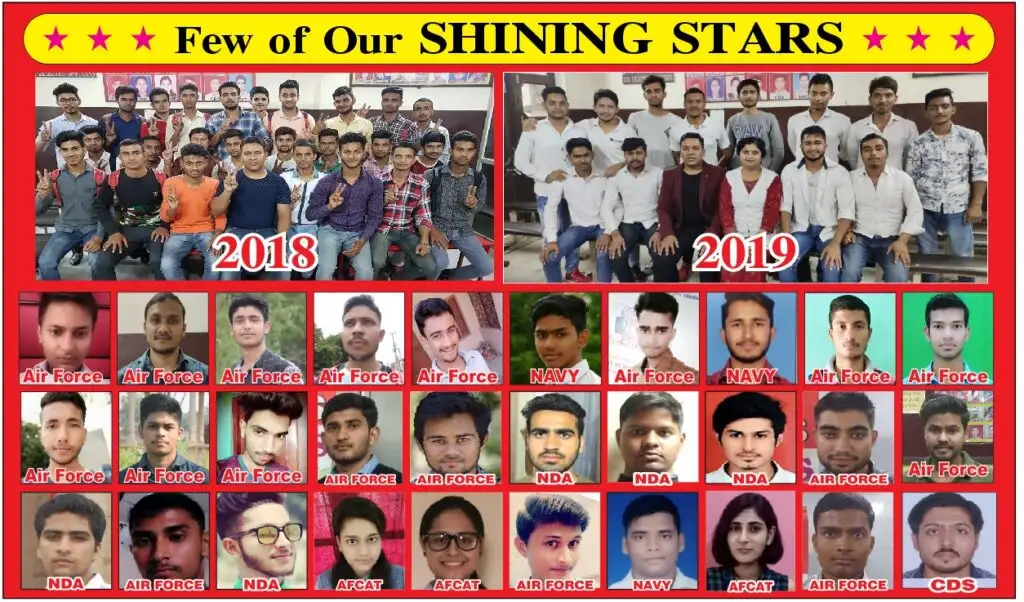Ramsar Sites In India

As of 3rd June 2021 there are 42 Ramsar sites in India . Ramsar sites in India are wetlands deemed to be of “international importance” under the Ramsar Convention. A wetland is a place where the land is covered by water. Marshes, ponds, the edge of a lake/ocean, the delta at the mouth of a river, low-lying areas that frequently flood — all of these are wetlands. Wetlands of international importance in India are also known as Ramsar sites in India.
Ramsar Convention
- Ramsar is a city in Iran. In 1971, an international treaty for the conservation and sustainable use of wetlands was signed at Ramsar.
- It is an international treaty for “the conservation and sustainable use of wetlands”.
- It is also known as the Convention on Wetlands.
- The Convention’s mission is “the conservation and wise use of all wetlands through local and national actions and international cooperation.

Ramsar Sites in India & across the World
- Today, the Ramsar List is the world’s largest network of protected areas.
- There are currently over 2,300 Ramsar Sites around the world. They cover over 2.5 million square kilometres, an area larger than Mexico.
- The world’s first Site was the Cobourg Peninsula in Australia, designated in 1974.
- The largest Sites are Ngiri-Tumba-Maindombe in the Democratic Republic of Congo and Queen Maud Gulf in Canada; these Sites each cover over 60,000 square kilometres.
- The countries with the most Sites are the United Kingdom with 175 and Mexico with 142.
- Bolivia has the largest area with 148,000 km2 under Ramsar protection.
- Tso Kar wetland is the 42nd Ramsar sites in India & the second in the UT of Ladakh.The Tso Kar Basin is a high-altitude wetland complex, consisting of two principal waterbodies, Startsapuk Tso, a freshwater lake to the south, & Tso Kar itself, a hypersaline lake to the north, situated in the Changthang region of Ladakh.
Ramsar Sites in India
As of June 2021, there are 42 Ramsar Sites in India (Wetlands).
Tso Kar wetland is India’s 42nd Ramsar site & the second in the UT of Ladakh.The Tso Kar Basin is a high-altitude wetland complex, consisting of two principal waterbodies, Startsapuk Tso, a freshwater lake to the south, & Tso Kar itself, a hypersaline lake to the north, situated in the Changthang region of Ladakh.

| Ramsar Site | State | Area (km2) | Description | |
| 1 | Ashtamudi Wetland | Kerala | 614 | It is a natural backwater in Kollam district. River Kallada and Pallichal drains into it. It forms an estuary with Sea at Neendakara (famous fishing harbour in Kerala).National Waterway 3 passes through it. |
| 2 | Beas Conservation Reserve | Punjab | 64 | It is a 185-kilometre stretch of the Beas River.The stretch is dotted with islands, sand bars and braided channels.The Reserve hosts the only known population in India of the endangered Indus river dolphin.In 2017, a programme was initiated to re-introduce the critically endangered gharial. |
| 3 | Bhitarkanika Mangroves | Odisha | 650 | It is famous for its saltwater crocodiles and Olive ridley sea turtle.The core area of Bhitarkanika Wildlife Sanctuary was declared Bhitarkanika National Park.Bhitarkanika Wildlife Sanctuary includes Gahirmatha Marine Wildlife Sanctuary. Bhitarkanika Mangroves, a part of Bhitarkanika Wildlife Sanctuary was designated a Ramsar Wetland of International Importance in 2002. |
| 4 | Bhoj Wetland | Madhya Pradesh | 32 | The Wetland consists of two lakes located in the city of Bhopal.The two lakes are the Bhojtal and the Lower Lake. It is a humanmade reservoir. The largest bird of India, the Sarus crane is found here. |
| 5 | Chandra Taal | Himachal Pradesh | .49 | It is a high altitude lake.It supports IUCN Redlisted Snow Leopard. |
| 6 | Chilika Lake | Odisha | 1165 | It is a brackish water lagoon at the mouth of the Daya River.It is the largest coastal lagoon in India.Birds from as far as the Caspian Sea, Lake Baikal, Aral Sea and other remote parts Central Asia, Ladakh and Himalayas come here.In 1981, Chilika Lake was designated the first Indian wetland of international importance under the Ramsar Convention.Nalbana Bird Sanctuary is the core area of the Ramsar designated wetlands of Chilika Lake.The Irrawaddy dolphin (critically endangered) is the flagship species of Chilika lake.Chilka is home to the only known population of Irrawaddy dolphins in India. |
| 7 | Deepor Beel | Assam | 40 | A permanent freshwater lake in a former channel of the Brahmaputra river.It is a few kilometres to the left of Guwahati whereas Pobitora Wildlife Sanctuary is around 35 km to the right. |
| 8 | East Kolkata Wetlands | West Bengal | 125 | It is multiple use wetland that serves the city of Kolkata. |
| 9 | Harike Wetland | Punjab | 41 | It is a shallow water reservoir at the confluence of Beas and Sutlej rivers. |
| 10 | Hokera Wetland | Union Territory of J&K | 13.75 | It is only 10 km from Srinagar.It is a natural perennial wetland contiguous to the Jhelum basin. |
| 11 | Kanjli Wetland | Punjab | 1.83 | The stream is considered to be the most significant in the state from the religious point of view, as it is associated with the first guru of the Sikhs, Shri Guru Nanak. |
| 12 | Keoladeo National Park | Rajasthan | 28.73 | A complex of ten artificial, seasonal lagoons, varying in size.Vegetation is a mosaic of scrub and open grassland that provides habitat for breeding, wintering and staging migratory birds.The invasive growth of the grass Paspalum distichum has changed the ecological character of large areas of the site, reducing its suitability for certain waterbird species, notably the Siberian crane. |
| 13 | Keshopur-Miani Community Reserve | Punjab | 34 | The Site is an example of wise use of a community-managed wetland, which provides food for people and supports local biodiversity. |
| 14 | Kolleru Lake | Andhra Pradesh | 901 | A natural eutrophic lake situated between the river basins of the Godavari and the Krishna.It was previously a lagoon, but now it is several kilometres inland due to the coastline of emergence and delta formation. |
| 15 | Loktak Lake | Manipur | 266 | Loktak Lake is the largest freshwater lake in the north-eastern region of the country.Keibul Lamjao the only floating national park in the world floats over it. |
| 16 | Nalsarovar Bird Sanctuary | Gujarat | 123 | A natural freshwater lake (a relict sea) that is the largest natural wetland in the Thar Desert.The wetland is a lifeline for a satellite population of the endangered Indian Wild Ass. |
| 17 | Nandur Madhameshwar | Maharashtra | 14 | Construction of the Nandur Madhameshwar Weir at the confluence of the Godavari and Kadwa Rivers helped create a thriving wetland. |
| 18 | Nangal Wildlife Sanctuary | Punjab | 1 | Located in the Shiwalik foothills of Punjab.It supports abundant flora and fauna including threatened species, such as the endangered Indian pangolin and Egyptian vulture.It occupies a human-made reservoir constructed as part of the Bhakra-Nangal Project in 1961.The site is of historic importance as the Indian and Chinese Prime Ministers formalized the “Five Principles of Peaceful Coexistence” there in 1954. |
| 19 | Nawabganj Bird Sanctuary | Uttar Pradesh | 2 | It was renamed as Chandra Shekhar Azad Bird Sanctuary in 2015. |
| 20 | Parvati Arga Bird Sanctuary | Uttar Pradesh | 7 | It is a permanent freshwater environment consisting of two oxbow lakes.The Sanctuary is a refuge for some of India’s threatened vulture species: the critically endangered white-rumped vulture and Indian vulture. |
| 21 | Point Calimere Wildlife and Bird Sanctuary | Tamil Nadu | 385 | One of the last remnants of Dry Evergreen Forests.Habitat: Dry Evergreen Forests, Mangrove & Wetlands. |
| 22 | Pong Dam Lake | Himachal Pradesh | 156.62 | It is also known as Maharana Pratap Sagar. |
| 23 | Renuka Lake | Himachal Pradesh | .2 | A natural wetland with freshwater springs and inland subterranean karst formations. |
| 24 | Ropar Wetland | Punjab | 13.65 | A humanmade wetland of lake and river formed by the construction of a barrage for diversion of water from the Sutlej River. |
| 25 | Rudrasagar Lake | Tripura | 2.4 | It is a reservoir fed by three perennial streams discharging to the River Gomti.It is an ideal habitat for IUCN Redlisted Three-striped Roof Turtle. |
| 26 | Saman Bird Sanctuary | Uttar Pradesh | 5 | It is a seasonal oxbow lake on the Ganges floodplain. |
| 27 | Samaspur Bird Sanctuary | Uttar Pradesh | 8 | It is a perennial lowland marsh typical of the Indo-Gangetic Plains.The Sanctuary harbours threatened species such as the endangered Egyptian vulture. |
| 28 | Sambhar Lake | Rajasthan | 240 | The Sambhar Salt Lake is India’s largest inland saltwater lake.It is a key wintering area for tens of thousands of flamingos. |
| 29 | Sandi Bird Sanctuary | Uttar Pradesh | 3 | The wetland is typical of the Indo-Gangetic plains. |
| 30 | Sarsai Nawar Jheel | Uttar Pradesh | 2 | It is a permanent marsh.It is an example of co-habitation of humans and wildlife.The site’s name is derived from the large non-migratory sarus crane. |
| 31 | Sasthamkotta Lake | Kerala | 3.73 | It is the largest freshwater lake in Kerala, situated in Kollam district.River Kallada had a unique replenishing system through a bar of paddy field.The lake is now depleting due to destruction of replenishing mechanism. |
| 32 | Sundarban Wetland | West Bengal | 4230 | Sundarban Wetland is located within the largest mangrove forest in the world.It is the largest Ramsar Site in India.The Indian Sundarban, covering the south-westernmost part of the delta, constitutes over 60% of the country’s total mangrove forest area and includes 90% of Indian mangrove species. |
| 33 | Surinsar-Mansar Lakes | Union Territory of J&K | 3.5 | Freshwater composite lake in semi-arid Panjab Plains, adjoining the Jhelum Basin. |
| 34 | Tsomoriri (Tso Moriri) | Union Territory of Ladakh | 120 | A freshwater to brackish lake lying at 4,595m above sea level.The site is said to represent the only breeding ground outside of China for one of the most endangered cranes, the Black-necked crane, and the only breeding ground for Bar-headed geese in India.The Great Tibetan Sheep or Argali and Tibetan Wild Ass are endemic to the region.With no outflow, evaporation in the arid steppe conditions causes varying levels of salinity. |
| 35 | Upper Ganga River (Brijghat to Narora Stretch) | Uttar Pradesh | 265.9 | The river provides habitat for IUCN Red listed Ganges River Dolphin and Gharial Crocodile. |
| 36 | Vembanad-Kol Wetland | Kerala | 1512.5 | Largest lake of Kerala, spanning across Alappuzha, Kottayam, and Ernakulam districts.It is the second largest Ramsar Site in India after Sundarbans.It is also the Longest lake of India.It is below sea level and is famous for exotic fish varieties and Paddy fields that are below sea level. |
| 37 | Wular Lake | Union Territory of J&K | 189 | It is the largest freshwater lake in India. |
| 38 | Asan Barrage | Uttarakhand | 4.44 | It is a stretch of the Asan River running down to its confluence with the Yamuna River in the Dehradun district.The stretch supports many species of birds including the critically endangered red-headed vulture (Indian black vulture), white-rumped vulture and Baer’s pochard. |
| 39 | Kanwar Taal or Kabar Taal Lake | Bihar, Begusarai | 26.2 | It lies in the Indo-Gangetic Plain.The wetland is an important stopover for the Central Asian Flyway migratory waterbirds.Five critically endangered species inhabit the site, including three vultures – the red-headed vulture, white-rumped vulture and Indian vulture – and two waterbirds, the sociable lapwing and Baer’s pochard. |
| 40 | Sur Sarovar | Uttar Pradesh, Agra district | 4.31 | It was created to supply water to the city of Agra.The wetland is an important stopover for the Central Asian Flyway migratory waterbirds. |
| 41 | Lonar Lake | Maharashtra, Buldhana district | 4.27 | It is an endorheic (closed basin) crater lake formed by a meteorite impact.It is high in salinity and alkalinity due to the lack of an outflow.Recently, the colour of Lonar lake water had turned pink due to a large presence of the salt-loving “haloarchaea” microbes.Haloarchaea or halophilic archaea is a bacteria culture that produces pink pigment and is found in water saturated with salt. |
| 42 | Tso Kar | Ladakh, Leh district | 95.77 | Tso Kar wetland is India’s 42nd Ramsar site & the second in the UT of Ladakh. The Tso Kar Basin is a high-altitude wetland complex, consisting of two principal waterbodies, Startsapuk Tso, a freshwater lake to the south, &Tso Kar itself, a hypersaline lake to the north, situated in the Changthang region of Ladakh. It is called Tso Kar, meaning white lake, because of the white salt efflorescence found on the margins due to the evaporation of highly saline water. Tso Kar Basin is an Important Bird Area according to BirdLife International.It is a key staging site in the Central Asian Flyway.Also, the site is the most important breeding areas of the Black-necked Cranes in India. |
| State/UT | No. of Ramsar Sites |
| Ut |
Students can come and join THE ORIGINAL TUTORS for SSB, Best Airforce/NDA/ X/Y ,CDS & AFCAT Coaching in Meerut. www.theoriginaltutors.com

Online Classes for SSB : Join & feel the difference
- All energetic, dynamic & passionate youth looking for a very diverse and exciting & adventurous career.
- Apart from flying one has to manage hundreds of personnel on base camp, formulate high-level strategies and tactics.
- During the calamities and emergencies, they step further and carry food and crucial supplies. If all the above-mentioned duties, gives you adrenaline rush then a career as an Air Force Officer is the right choice for you.
- Come and join THE ORIGINAL TUTORS, the Best Airforce/NDA/ X/Y & AFCAT Coaching in Meerut.
- THE ORIGINAL TUTORS has manifested method of teaching by the systematic application of the scientific methods, demonstrations, diagrammatical presentations, Audio-video presentations, Group discussions, Newspaper sessions.
- All these specific learning technique have made the teaching-learning process more entertaining.
- This directs complete concentration over the attainable objectives of the students.
- We clearly understand that every student has his own understanding level, intelligence, liking and disliking, thoughts, social environment, capabilities, positives and area of improvement.
Read More Posts related to SSB
For important SSB Topics, Current Affairs, GD Topics and tips of written examinations which helps you in AirForce X/Y , NDA, CDS, AFCAT & SSB: http://airforcecoaching.in/airforce-x-y-gd-topics/
10+2 TES SSB Entry 2022 – THE ORIGINAL TUTORS (airforcecoaching.in)
















